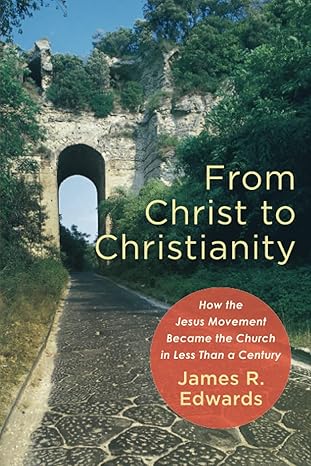A Book Review from Books At a Glance
by Andrew S. Ballitch
Summary and Review
James Edwards compares and contrasts the ministry of Jesus and the church of Ignatius’s day. Jesus’s ministry took place roughly 30 A.D. and the epistles of Ignatius date around 100 A.D. The two were separated by about one lifetime and in this period radical changes took place, if not in essence, at the very least in the form of Christianity. What emerged has endured for two-thousand years. The question Edward’s seeks to answer is, how such significant adaptation took place so rapidly? He offers an illustrative summary of his argument in his conclusion:
“The transitions from the Jesus movement to the Christian church that we traced in this book were largely accomplished between the death of Jesus and the death of Ignatius of Antioch. These seventy-five years witnessed the greatest and most formative changes in the history of Christianity. The changes did not happen either simultaneously or sequentially, and they were not the result of a centralized plan of any person or party in the early church. Like the various plant and animal life forms that are attracted and nourished by a water source, the changes were organic responses of the early church to its conviction of the preeminence of Christ and the mission consciousness (which necessarily resulted from the preeminence of Christ) to proclaim the gospel to the nations” (249).
The fourteen changes, contrasts, or points of evolution serve as Edwards’s chapters and the evidence for his thesis.
- From Rural to Urban
- From Jerusalem to Rome
- From Jerusalem to the East and South
- From Hebrew to Greek
- From Jesus Movement to Gentile Mission
- From Jesus Movement to Roman Persecution
- From Torah to Kerygma
- From Synagogue to Church
- From Jewish to Christian Ethos
- From Passover to Eucharist
- From Apostles to Bishops
- From Sabbath to Sunday
- From “Way” to “Christian”
- From Scroll to Codex
Edwards’s research focuses on the New Testament, the Apostolic Fathers, and relevant primary sources of the period terminating in the middle of the second century, informed by the vast secondary literature pertinent to each. The breadth and depth of engagement with these sources is indicative of a lifelong scholarly career in the field. While at the same time the craft of quality writing has clearly been honed, as the pace and prose carry the reader along with both clarity and creativity.
While Edwards is self-consciously breaking new ground with the entirety of his study, at least for his non-specialist audience, with his focus on the earliest decades of the post-Apostolic church, his chapter on the spread of Christianity to the south and east of Israel is especially welcome. As he points out, the spread of Christianity to the west is familiar, as it is narrated in the book of Acts and is the tradition that those of us in the west inherited. However, Christianity spread in these other directions as well and communities of Christians thrived for centuries, even though they never experienced the relief from persecution that western Christians enjoyed with the conversion of Constantine and the establishment of Christendom in the fourth century. One feature of Christianity outside the Roman empire that Edwards notes but does not evaluate is the prevalence of Christological heresy. The Christian communions that existed and continued to spread to the south and east were marked by the rejection of the Chalcedonian formula of 451 one way or another.
While Edwards’s offering is fresh and therefore insightful and valuable as far as it goes, a more interesting and helpful question could have been asked of the same historical period and slate of sources. What changed from the close of the Apostolic era to the end of the period of the Apostolic Fathers, namely, between the close of the New Testament and Justin Martyr? Lumping everything together after the earthly ministry of Jesus recorded in the Gospels muddies the waters for those who are trying to figure out what was timeless and what is normative for the church. Paul should be given precedence over Polycarp and the Catholic Epistles priority over the epistles of Clement, even when investigating the transformation of early Christian worship practices and community expectations.
Related to this, Edwards makes an equally unhelpful distinction between the essence and form of Christianity. It is related in so far as the form of Christianity, the ecclesiology, promulgated by the New Testament, is part of its essence. This is part of the reason why one ought not draw a line between Jesus and what comes after, but rather, between the New Testament and subsequent testimonies. Trying to find some other determinative kerygma within the husk harkens back to Harnack and the failed project of Protestant Liberalism. Those in the Early Christian Studies field at times make little distinction between the canon of the New Testament and extra-biblical sources, but churches must.
Reviewer Bio
Andrew S. Ballitch (PhD, The Southern Baptist Theological Seminary) is a pastor at Westwood Alliance Church in Mansfield, Ohio.
